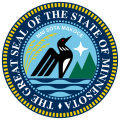| Elections in Minnesota |
|---|
 |
Results and election information for past Minnesota governor races. The first election was in 1857 ahead of Minnesota becoming a state. Elections were set for every two years beginning in 1859. In 1886 elections were moved from odd years to even years. In 1962 the governor's term increased to 4 years.
- 1857 Minnesota gubernatorial election
- 1859 Minnesota gubernatorial election
- 1861 Minnesota gubernatorial election
- 1863 Minnesota gubernatorial election
- 1865 Minnesota gubernatorial election
- 1867 Minnesota gubernatorial election
- 1869 Minnesota gubernatorial election
- 1871 Minnesota gubernatorial election
- 1873 Minnesota gubernatorial election
- 1875 Minnesota gubernatorial election
- 1877 Minnesota gubernatorial election
- 1879 Minnesota gubernatorial election
- 1881 Minnesota gubernatorial election
- 1883 Minnesota gubernatorial election
- 1886 Minnesota gubernatorial election
- 1888 Minnesota gubernatorial election
- 1890 Minnesota gubernatorial election
- 1892 Minnesota gubernatorial election
- 1894 Minnesota gubernatorial election
- 1896 Minnesota gubernatorial election
- 1898 Minnesota gubernatorial election
- 1900 Minnesota gubernatorial election
- 1902 Minnesota gubernatorial election
- 1904 Minnesota gubernatorial election
- 1906 Minnesota gubernatorial election
- 1908 Minnesota gubernatorial election
- 1910 Minnesota gubernatorial election
- 1912 Minnesota gubernatorial election
- 1914 Minnesota gubernatorial election
- 1916 Minnesota gubernatorial election
- 1918 Minnesota gubernatorial election
- 1920 Minnesota gubernatorial election
- 1922 Minnesota gubernatorial election
- 1924 Minnesota gubernatorial election
- 1926 Minnesota gubernatorial election
- 1928 Minnesota gubernatorial election
- 1930 Minnesota gubernatorial election
- 1932 Minnesota gubernatorial election
- 1934 Minnesota gubernatorial election
- 1936 Minnesota gubernatorial election
- 1938 Minnesota gubernatorial election
- 1940 Minnesota gubernatorial election
- 1942 Minnesota gubernatorial election
- 1944 Minnesota gubernatorial election
- 1946 Minnesota gubernatorial election
- 1948 Minnesota gubernatorial election
- 1950 Minnesota gubernatorial election
- 1952 Minnesota gubernatorial election
- 1954 Minnesota gubernatorial election
- 1956 Minnesota gubernatorial election
- 1958 Minnesota gubernatorial election
- 1960 Minnesota gubernatorial election
- 1962 Minnesota gubernatorial election
- 1966 Minnesota gubernatorial election
- 1970 Minnesota gubernatorial election
- 1974 Minnesota gubernatorial election
- 1978 Minnesota gubernatorial election
- 1982 Minnesota gubernatorial election
- 1986 Minnesota gubernatorial election
- 1990 Minnesota gubernatorial election
- 1994 Minnesota gubernatorial election
- 1998 Minnesota gubernatorial election
- 2002 Minnesota gubernatorial election
- 2006 Minnesota gubernatorial election
- 2010 Minnesota gubernatorial election
- 2014 Minnesota gubernatorial election
- 2018 Minnesota gubernatorial election
- 2022 Minnesota gubernatorial election
- 2026 Minnesota gubernatorial election